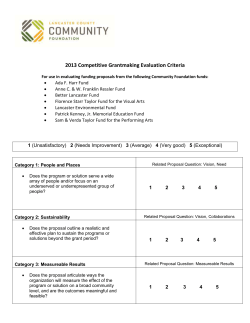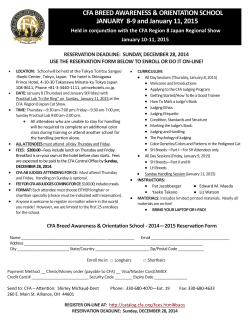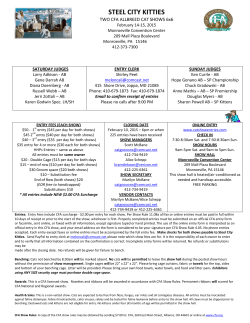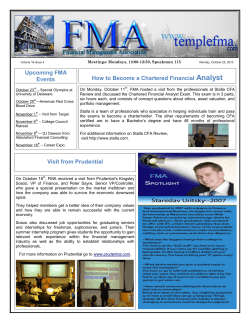
CHAPTER 4 MEASURES OF LEVERAGE Presenter’s name Presenter’s title
CHAPTER 4 MEASURES OF LEVERAGE Presenter’s name Presenter’s title dd Month yyyy 1. INTRODUCTION Leverage is the use of fixed costs in a company’s cost structure. - Operating leverage relates to the company’s operating cost structure. - Financial leverage relates to the company’s capital structure. Fixed Costs Copyright © 2013 CFA Institute Fixed Costs 2 WHY WORRY ABOUT LEVERAGE? 1. A company’s use of leverage affects its risk and return. 2. Operating leverage and financial leverage provide insight into a company’s business and its future. 3. Leverage helps us understand a company’s future cash flows and the risk associated with those cash flows and, hence, its valuation. Copyright © 2013 CFA Institute 3 2. LEVERAGE • Leverage increases the volatility of earnings and cash flows → hence, it increases risk to suppliers of capital (creditors and owners). • Consider two companies, Company One and Company Two, with the following information: Company Company One Two Number of units produced and sold Sales price per unit Variable cost per unit Fixed operating cost Fixed financing expense Debt Equity Total assets Copyright © 2013 CFA Institute 1,000 €250 €125 €50,000 €5,000 1,000 €250 €25 €100,000 €55,000 €50,000 €700,000 €750,000 €550,000 €200,000 €750,000 4 WHAT DOES LEVERAGE DO EXACTLY? Company Two uses more operating and financial leverage than Company One. Company One Company Two € 200,000 € 150,000 € 100,000 Net Income € 50,000 €0 -€ 50,000 -€ 100,000 -€ 150,000 Number of Units Produced and Sold Copyright © 2013 CFA Institute 5 3. BUSINESS RISK AND FINANCIAL RISK • Business risk is the risk associated with the volatility in operating earnings. - Business risk is composed of both operating and sales risk. • Sales risk is the uncertainty associated with the number of units produced and sold, as well as the sales price. Operating Risk Sales Risk Business Risk Copyright © 2013 CFA Institute 6 OPERATING RISK • Operating risk is the risk associated with the mix of variable and fixed operating expenses. - Operating risk is the sensitivity (i.e., elasticity) of operating earnings to changes in unit sales. • The degree of operating leverage (DOL) is the ratio of the percentage change in operating income to the percentage change in units sold. • The per unit contribution margin is the difference between the sales price and the variable cost per unit. This difference is available to cover fixed operating costs. - Overall, for all units sold, the contribution margin is the difference between total revenues and variable operating costs. Copyright © 2013 CFA Institute 7 DOL The DOL is at Q units produced and sold: DOL= Q (P − V) Q P−V −F (4-2) where Q is the number of units P is the price per unit V is the variable operating cost per unit and F is the fixed operating cost Copyright © 2013 CFA Institute 8 EXAMPLE: COMPANY ONE AND COMPANY TWO COMPANY ONE DOL1,000 = 1,000(€250 − €125) 1,000 €250 − €125 − €50,000 €125,000 DOL1,000 = €75,000 DOL1,000 = 1.667% Copyright © 2013 CFA Institute COMPANY TWO DOL1,000 = 1,000 (€250 − €25) 1,000 €250 − €25 −€100,000 DOL1,000 = €225,000 €125,000 DOL1,000 = 1.800 9 FINANCIAL RISK • Financial risk is the risk associated with the choice of financing the business. - The greater the reliance on fixed-cost obligations, such as debt, the greater the financial risk. - Similar to operating risk, financial risk elasticity is the sensitivity of income available to owners to a change in operating earnings. • The degree of financial leverage (DFL) is the ratio of the percentage change in net income to the percentage change in operating income. Copyright © 2013 CFA Institute 10 DFL At a specific level of operating earnings (and, therefore, Q): DFL= Q(P − V) − F QP−V −F−C (4-4) where Q, P, V, and F are as before, and C is the fixed financial cost. Copyright © 2013 CFA Institute 11 Company Two Company One EXAMPLE: COMPANY ONE AND COMPANY TWO 1,000(€250 − €125) − €50,000 DFL1,000 = 1,000 €250 − €125 − €50,000 − €5,000 €75,000 DFL1,000 = €70,000 DFL1,000 = 1.071% 1,000(€250 − €25) − €100,000 DFL1,000 = 1,000 €250 − €25 − €100,000 − €55,000 Copyright © 2013 CFA Institute €125,000 DFL1,000 = €70,000 DFL1,000 = 1.786% 12 RETURN ON EQUITY AND THE DFL • The greater the degree of financial leverage, the greater the financial risk. • We can see the leveraging effect by looking at the return on equity (ROE) for different levels of units produced and sold. • The greater the DFL, the more sensitive the ROE is to changes in the units produced and sold. Copyright © 2013 CFA Institute 13 EXAMPLE: RETURN ON EQUITY Consider the example of Company One and Company Two: 100% 80% 60% 40% Return on 20% Equity 0% -20% -40% -60% -80% Company One Company Two Units Produced and Sold Copyright © 2013 CFA Institute 14 DEGREE OF TOTAL LEVERAGE • Total leverage is the combined effect of operating leverage and financial leverage. • The degree of total leverage (DTL) is the product of the degree of operating leverage and the degree of financial leverage: DTL = Q(P − V) QP−V −F−C (4-6) Or, equivalently: DTL = DOL × DTL • If DOL is 3 and DFL is 2, DTL = 2 × 3 = 6. - So, a 1% change in the units produced and sold results in a 6% change in the earnings to owners. Copyright © 2013 CFA Institute 15 Company Two Company One EXAMPLE: COMPANY ONE AND COMPANY TWO 1,000(€250 − €125) DTL1,000 = 1,000 €250 − €125 − €50,000 − €5,000 €125,000 DFL1,000 = €70,000 DFL1,000 = 1.786 1,000(€250 − €25) DTL1,000 = 1,000 €250 − €25 − €100,000 − €55,000 Copyright © 2013 CFA Institute €225,000 DFL1,000 = €70,000 DFL1,000 = 3.214 16 BREAKEVEN QUANTITY • The breakeven point (QBE) is the level of units produced and sold at which the costs (both variable and fixed) are just covered—that is, net income is zero. • The breakeven point is 𝑄𝐵𝐸 = 𝐹+𝐶 𝑃−𝑉 (4-7) • The operating breakeven point (QOBE) is the level of units produced and sold at which the operating costs are covered. 𝐹 𝑄𝑂𝐵𝐸 = 𝑃−𝑉 Copyright © 2013 CFA Institute 17 Company Two Company One EXAMPLE: COMPANY ONE AND COMPANY TWO Copyright © 2013 CFA Institute Breakeven= €55,000 = 440 units €250 − €125 Operating breakeven= Breakeven= €50,000 = 400 units €250 − €125 €155,000 = 689 units €250 − €25 Operating breakeven= €100,000 = 444 units €250 − €25 18 RISKS TO CREDITORS AND OWNERS • Business risk is affected by demand uncertainty, output price uncertainty, and cost uncertainty. • Financial risk adds to the company’s business risk, increasing the risk to creditors and owners. • The creditor claims are fixed, whereas the equity claims are residual. • In the event that creditor claims cannot be satisfied, there may be legal statuses that help sort out the claims: - Reorganization is the restructuring of claims, with the expectation that the company will be able to continue, in some form, as a going concern. - Liquidation is the situation in which assets are sold and then the proceeds distributed to claimants. Copyright © 2013 CFA Institute 19 4. SUMMARY • Leverage is the use of fixed costs in a company’s cost structure. • Business risk is the risk associated with operating earnings and reflects - sales risk (uncertainty with respect to the price and quantity of sales) and - operating risk (the risk related to the use of fixed costs in operations). • Financial risk is the risk associated with how a company finances its operations (i.e., the split between equity and debt financing of the business). Copyright © 2013 CFA Institute 20 SUMMARY (CONTINUED) • The degree of operating leverage (DOL) is the sensitivity of operating earnings to changes in units produced and sold. • The degree of financial leverage (DFL) is the sensitivity of cash flows to owners to changes in operating earnings. • The degree of total leverage (DTL) is the sensitivity of the cash flows to owners to changes in unit sales. • The breakeven point, QBE, is the number of units produced and sold at which the company’s net income is zero. • The operating breakeven point, QOBE, is the number of units produced and sold at which the company’s operating income is zero. Copyright © 2013 CFA Institute 21
© Copyright 2025













